Knowledge
Ningxia Fructus
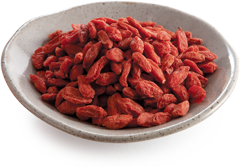 Introduction:
Introduction:
Fructus is the fruit of Chinese Fructus. It was founded in NingXia, China. Called also Xi Fructus (西杞子).
Function:
The medical functions of Ningxia Fructus: Enrich the functions of liver and kidney, Brighten the eyes and bring about youthful complexion. It is good for weakness after illness, fainting or seeing things not clear with blurred vision.
Standard:
Slightly sweet in taste, calm and neutral in nature.
Processing method:
Wash the Ningxia Fructus thoroughly. Cooking can begin.
Way of Storage:
Place the Ningxia Fructus in cool and dry place. If it is to be stored for some time before serving, it should be sealed and place in refrigerator (0-8˚C).
Note: This product will discolour when washing by water, this is natural but not artificial.
Serving Suggestions:
Ningxia Fructus (25g), Henan Huai Shan (50g), Dried longan pulp (Thailand)(25g), Rui Ren Rou (Hedge Prinsepia Nut)(15g), Ri Yue fish (100g), Lean Pork (800g) Boil the above Ingredients with adequate water, then you can enjoy a healthful soup. It will clear the liver and bright the eye. Nourishing Yi and enriching liver.
Henan Huai Shan
Henan Huai ShanIntroduction:
Henan Huai Shan is the root of Wild Yam (Dioscorea Villosa). It was founded in HuaiQing, Henan, China. Called also Henan Huai Shan河南懷山).
Function:
The medical functions of Henan Huai Shan: Enrich the functions of spleenand stomach, can be used as nourishing, stopping over-sweating, enriching digestion and stopping diarrhoea, enriching the absort functions of stomach and intestines.
Standard:
Slightly sweet in taste, calm in nature.
Processing method:
Wash the Henan Huai Shan thoroughly. Cooking can begin.
Note: This product has been treated with sulfur, must be soaked and washed thoroughly; otherwise the taste will become sour.
Way of Storage:
Place the Henan Huai Shan in cool and dry place. If it is to be stored for some time before serving, it should be sealed and place in refrigerator (0-8˚C).
Serving Suggestions:
Henan Huai Shan (50g), Bei Qi (15g), Wen Dang (25g), NingXia Wolfberry (25g), Dried longan pulp (Thailand)(25g), Old Chicken 1, Boil the above Ingredients with adequate water, then you can enjoy a healthful soup. Enriching the spleen and liver, nourishing the whole body as well.
Wen Dang
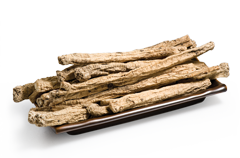 Introduction:
Introduction:
Wen Dang is the root of Codonopsis pilosula. It was founded in WenXian, GanSu, China and called as Wen Dang.
Function:
The medical functions of Wen Dang: harmonizing the spleen and stomach. corrects blood deficiency and enhances qi. Suitable for weakness of limbs, deficiency of blood and qi, weakness of spleen and stomach, dry tongue and thirsty.
Standard:
Slightly sweet in taste, neutral in nature.
Processing method:
Chop the Wen Dang into sections, soak in water for half of an hour, wash thoroughly. Cooking can begin.
Note: The Wen Dang has been treated with sulfur, must be soaked and washed thoroughly, otherwise the taste will become sour.
Way of Storage:
Wen Dang should be sealed and place in cool and dry place. If it is to be stored for some time before serving, it should be sealed and place in refrigerator (0-8˚C).
Serving Suggestions:
Wen Dang (30g), Ling Zhi (Ganoderma lucidum) (40g), Dried longan pulp (Thailand)(25g), Heart shaped Jujube 5, Squab 2 Boil the above Ingredients with adequate water, then you can enjoy a healthful soup. It will Nourishing and bring about youthful complexion Calms heart and mentality
Sichuan fritillaria
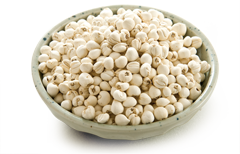 Introduction:
Introduction:
Sichuan fritillaria is the root of Fritillaria cirrhosa D. Don. It was founded in Szechwan, China.
Function:
The medical functions of Sichuan fritillaria: Moistures lungs and clear heat. Stop cough and reduce phlegm. Suitable for weakness, chronic cough, uneasy breathing, etc.
Standard:
Slightly bitter in taste, cool in nature.
Processing method:
The Original colour Sichuan fritillaria just wash thoroughly is enough. The Non- Original colour Sichuan fritillaria must soak in water for 1 hour then wash thoroughly. Cooking can begin.
Note: The Non- Original colour Sichuan fritillaria has been treated with sulfur, must be soaked and washed thoroughly, otherwise the taste will become sour.
Way of Storage:
Sichuan fritillaria should be sealed and place in refrigerator (0-8˚C). If it is to be stored for some time before serving, it should be sealed and place in Freezer (-18˚C).
Serving Suggestions:
Original Colour Sichuan fritillaria (25g), Africa Sea Coconut (25g), Bai He (50g), Sweet Apricot Kernels and Bitter Apricot Kernels (25g), Fig (100g), Lean Pork (800g) Boil the above Ingredients with adequate water, then you can enjoy a healthful soup. It will enhance the Xi and moisture the lung, stop cough and reduce phlegm.
Solomon's Seal
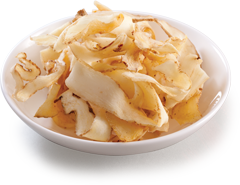 Introduction:
Introduction:
Solomon's seal is the root of Polygonatum in the family Ruscaceae. It is commonly used for cooking soup with poultry or desserts. Mainly produced in the Hunan area in China.
Function:
Solomon's seal has the function of moisturizing the body, providing yin energy, stimulate saliva secretion and improving circulation. Suitable for curing heat and dryness of lungs, coughing, thirstiness, and fever due to tiredness and deficiency.
Standard:
Sweet, neutral in nature.
Processing method:
Solomon's seal should be stored under good ventilation and avoid sunlight. If planned to store for a longer period, please seal and put into the refrigerator (0-8˚C).
Note: This product has been treated with sulfur, must be soaked and washed thoroughly, otherwise the taste will become sour.
Way of Storage:
Solomon's seal should be stored under good ventilation and avoid sunlight. If planned to store for a longer period, please seal and put into the refrigerator (0-8˚C).
Note: This product has been treated with sulfur, must be soaked and washed thoroughly, otherwise the taste will become sour.
Serving Suggestions:
Make soup with 1 tael Solomon's seal, 3 maces American ginseng, 1 tael white lotus seed, 5 maces bulbus lily, 1 tael Henan Chinese wild yam, 5 maces Thai longan flesh, 1 catty lean pork. Has the function of strengthening yin power, nourishing lungs and spleen, improving respiration.
Giehnia Root
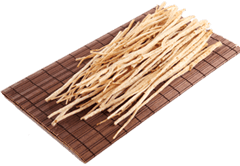 Introduction:
Introduction:
Glehnia root is the root of Glehnia littoralis in the carrot family. It is also called "Bei Sha Shen", and is mainly produced in the Shandong are in China.
Function:
Glehnia root has the function of strengthening yin energy, nourishing and clearing the lungs, resolving phlegm and relieving cough, and increase saliva secretion, nourishing the spleen and stomach. Suitable for curing coughing due to heat, fever due to deficiency, dry throats, and lacking of water in excrement.
Standard:
Sweet and calm, cool in nature.
Processing method:
Soak the Glehnia root in water for 1 hour, wash with clean water and it is ready for use.
Note: This product has been processed with sulphur, therefore must be soaked and washed thoroughly before cooking to avoid any sour taste.
Way of Storage:
Glehnia root should be stored under good ventilation and avoid sunlight. If planned to store for a longer period, please seal and put into the refrigerator (0-8˚C).
Serving Suggestions:.
Make soup with 1 tael Glehnia root, 5 maces Solomon's seal, 1 tael white lotus seed, 5 maces bulbus lily, 1 tael Henan Chinese wild yam, 1 tael euryale seeds, 5 maces Thai logan flesh, 1 tael barley, 1 catty lean pork. Has the function of retreating the heat, nourishing the lungs, spleen and stomach.
Gastrodia Tuber
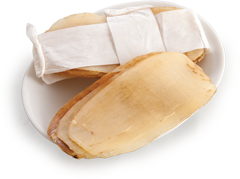 Introduction:
Introduction:
Gastrodia Tuber is the tuber of Gastrodia which belongs to the genus orchid. It is mainly produced in Anhui and Yunan in China. Since it is processed by adding ginger, it is also called "ginger Gastrodia tuber"
Function:
Gastrodia tuber has the function of calming the internal wind and the mind, relax the meridians and work as a painkiller. Suitable for treating faintness, headache, nervous depression, numbness of limbs.
Standard:
Sweet and spicy, slightly warm in nature.
Processing method:
Soak the Gastrodia tuber slices for 1 hour, wash with water and they are ready for cooking.
Note: This product has been processed with sulphur, therefore must be soaked and washed thoroughly before cooking to avoid any sour taste.
Way of Storage:
Gastrodia tuber slices should be stored under good ventilation and avoid sunlight. If planned to store for a longer period, please seal and put into the refrigerator (0-8˚C).
Serving Suggestions:
Make soup with 5 maces Gastrodia tuber slices, 3 maces Chinese angelica root, 2 maces Sichuan lovage root, 2 maces angelica root (angelicae dahuricae), 5 heart-shaped jujubes, 3 slices ginger, 1 big fish head, 12 taels lean pork. Has the function of calming the internal wind and curing coldness, improves circulation and has analgesic effect.
Shan Dong E-jiao
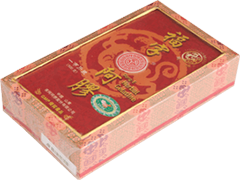 Introduction:
Introduction:
Shan Dong E-jiao is a glue processed from the hair-removed skin of donkey which belongs to the horse family, by boiling with yellow wine, crystal sugar and soya oil. It is mainly produced in the E County in Shan Dong, China.
Function:
Shan Dong E-jiao promotes blood production and stops bleeding, provides yin energy and moisturizes the body, treats deficiency of vital energy and prevents miscarriage. Suitable for people who have pale looks, tired and deficient from vital energy, suffering from faintness or cardiopalmus.
Standard:
Sweet, neutral in nature.
Processing method:
Wash the Shan Dong E-jiao with water and it is ready for cooking.
Way of Storage:
Shan Dong E-jiao should be stored under good ventilation and avoid sunlight.
Serving Suggestions:
Boil water with 8 maces Shan Dong E-jiao, 2 eggs, adequate crystal sugar. Has the function of providing yin energy, promoting blood production, treating deficiency and moisturizing the body.
Cooking Service:
Stewing is a general but time-consuming method for serving E-Jiao. Using our E-Jiao cooking service, customers can easily enjoy E-Jiao Date Cakes with Walnut. Customers may inquire our shop assistants for further information.
Chinese Angelica Root
 Introduction:
Introduction:
Chinese angelica root is the root of Angelica sinensis, which belongs to the family Apiaceae. It is mainly produced in the Gansu area in China.
Function:
Chinese angelica root has the function of promote blood production and enhance circulation, ease menstrual pain, and assist evacuation of the bowels. Suitable for treating blood deficiency and headache, irregular menstrual cycle, physical weakness and deficiency of vital energy, and curing cold limbs.
Standard:
Sweet and spicy, warm in nature.
Processing method:
Soak the Chinese angelica root in water for 1 hour, wash with clean water and it is ready for cooking.
Note: This product has been processed with sulphur, therefore must be soaked and washed thoroughly before cooking to avoid any sour taste.
Way of Storage:
Chinese angelica root should be stored under good ventilation and avoid sunlight. If planned to store for a longer period, please seal and put into the refrigerator (0-8˚C).
Serving Suggestions:
Make soup with 3 maces Chinese angelica root, 3 maces Astragalus root, 5 maces Radix Codonopsis Pilosulae, 5 heart-shaped jujubes, 1 silkie. Has the function of promoting circulation, adjusting menstrual cycle and treats deficiency of vital energy.
Astragalus Root
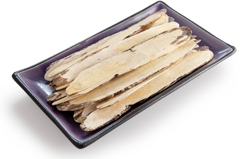 Introduction:
Introduction:
Astragalus root is the root of Astragalus membranaceus in the family Fabaceae. It is mainly produced in the Shanxi and Shaanxi areas in China.
Function:
Astragalus root has the function of promoting vital energy, nourishing the spleen, helps generate yang energy, and removes excess water from the body. Suitable for treating qi deficincy, cardiopalmus, heavy sweating, and helps recovery of wounds.
Standard:
Sweet, warm in nature.
Processing method:
Cut the Astragalus root into sections, wash with water and it is ready for cooking.
Way of Storage:
Astragalus root should be stored under good ventilation and avoid sunlight. If planned to store for a longer period, please seal and put into the refrigerator (0-8˚C).
Serving Suggestions:
Make soup with 4 maces Astragalus root, 2 maces winter worm grass, 1 small piece of sun-dried tangerine peel, 5 heart-shaped jujubes, 1 teal. Has the function of promoting yin energy and nourishing the kidneys, enrich vital energy and assist production of blood.
Pseudoginseng root
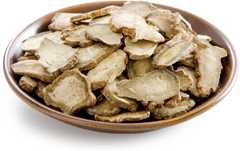 Introduction:
Introduction:
Pseudoginseng root is the root of Panax Pseudoginseng, which belongs to the genus Panax. The one with natural colour is called "natural colour pseudoginseng root" and has better effect over the others. Mainly produced in the Yunan area in China.
Function:
Pseudoginseng root has the function of easing bruises and stops bleeding, promotes circulation and relieves pain. Also works well for impact injuries, blood stasis, muscle pain, swelling joints and open wounds.
Standard:
Sweet and bitter, slightly warm in nature.
Processing method:
Cut pseudoginseng root into thick slices, wash with water and it is ready for use.
Way of Storage:
Pseudoginseng root should be stored under good ventilation and avoid sunlight. If planned to store for a longer period, please seal and put into the refrigerator (0-8˚C).
Serving Suggestions:
Make soup with 2 maces pseudoginseng root, 5 maces American ginseng, 4 candied jujubes, 1 catty lean pork. Has the effect of relaxing the meridian, improves circulation and kills pain.
Bighead atractylodes rhizome
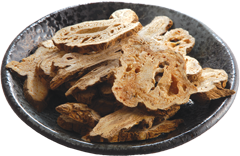 Introduction:
Introduction:
Bighead atractylodes rhizome is the rhizome of Atractylodis Macrocephalae, which belongs to the family Asteraceae. It is mainly produced in the Jiejiang area in China.
Function:
Bighead atractylodes rhizome enriches vital energy, nourishes the spleen, helps removing excess water from the body, and improves appetite and digestion. Suitable for treating heavy sweating.
Standard:
Sweet and bitter, slightly warm in nature.
Processing method:
Soak the bighead atractylodes rhizome in water for 1 hour, wash with clean water and it is ready for use.
Note: This product has been processed with sulphur, therefore must be soaked and washed thoroughly before cooking to avoid any sour taste.
Way of Storage:
Bighead atractylodes rhizome should be stored under good ventilation and avoid sunlight. If planned to store for a longer period, please seal and put into the refrigerator (0-8˚C).
Serving Suggestions:
Boil water with 5 maces bighead atractylodes rhizome, 5 maces Radix Codonopsis Pilosulae, 5 maces poria, 3 maces Glycyrrhiza uralensis root, 4 candied jujubes. Has the effect of nourishing the spleen, removing excess water from the body, promotes vital energy and circulation of qi.
Tuckahoe
 Introduction:
Introduction:
Tuckahoe is the sclerotium of Poria cocos (Schw.) Wolf, family Polyporaceae, there are some pine roots at the middle naturally, called as Indian Bread with Pine, found in Yunnan, China.
Function:
The medical functions of Tuckahoe: Enrich the functions of kidney and heart, used as diuretics & tranquilizer, Calms heart and mentality. It is for insomnia or forgetfulness.
Characteristics:
Slightly sweet in taste, calm and neutral in nature.
Processing method:
Soak in clean water for around 1 hour then wash thoroughly. Cooking can begin.
Note: This product has been treated with sulfur, must be soaked and washed thoroughly; otherwise the taste will become sour.
Way of Storage:
Place the Tuckahoe in cool and dry place. If it is to be stored for some time before serving, it should be sealed and place in refrigerator (0-8˚C).
Serving Suggestions:
Tuckahoe (50g), Wen dang (Codonopsis pilosula) (25g), Dried longan pulp (Thailand)(25g), Ripe Sour Jujube Seed (25g), Lean Pork (800g) Boil the above Ingredients with adequate water, then you can enjoy a healthful soup.
Fu ling
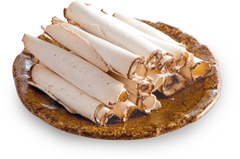 Introduction:
Introduction:
Fu ling (Poria) is the sclerotium of Poria cocos (Schw.) Wolf, family Polyporaceae was founded in Yunnan, China, called also Yun Ling (雲苓)
Function:
The medical functions of Fu ling (Poria): Enhancing the urination functions, remove wet from the body. Enrich the functions of spleen and stomach, used as diuretics & tranquilizer, Calms heart and mentality. It is for insomnia or forgetfulness.
Characteristics:
Slightly sweet in taste, calm and neutral in nature.
Processing method:
Soak in clean water for around 1 hour then wash thoroughly. Cooking can begin.
Way of Storage:
Place the Tuckahoe in cool and dry place. If it is to be stored for some time before serving, it should be sealed and place in refrigerator (0-8˚C).
Serving Suggestions:
Fu ling (Poria) (50g), Bai Shu(Atractylodes macrocephala)(Atractylodes macrocephala) (25g), Raw Coix Seed (50g), Ripe Coix Seed (25g), Bian Dou Yi (25g), 3 Sweet Jujube Boil the above Ingredients with adequate water and enjoy a healthful drink.
Mai Dong
 Introduction:
Introduction:
Mai Dong (Ophiopogon japonicus) is the roots of Liriope spicata, the natural colour is called as original colour Mai Dong (Ophiopogon japonicus), the medical functions will be better. The plant was originally found in Szechwan.
Function:
The original colour Mai Dong (Ophiopogon japonicus): Nourishing and moisturizing. Promotes body fluid and enriches vital energy. Moisturizing the lungs and prevent coughing. Enhancing heart and Calms mentality. Suitable for the symptoms of coughing without sputum, tire and weakness, fidgety, heat and thirsty.
Characteristics:
Slightly sweet in taste, slightly cold in nature.
Processing method:
The original colour Mai Dong (Ophiopogon japonicus) only wants to be wash thoroughly then can be served for cooking.
Way of Storage:
Place the Mai Dong (Ophiopogon japonicus) in cool and dry place. If it is to be stored for some time before serving, it should be sealed and place in refrigerator (0-8˚C).
Serving Suggestions:
The original colour Mai Dong (Ophiopogon japonicus) (25g), American Gengseng (25g), Dried longan pulp (Thailand)(50g), Adequate Sweet Jujube Boil the above Ingredients with adequate water, then you can enjoy a healthful drink. It brings you the functions of Nourishing and moisturizing, enhancing lungs and heart, promotes body fluid and enriches vital energy.
Gan Cao
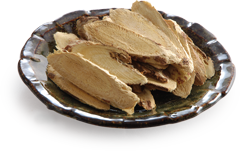 Introduction:
Introduction:
Gan Cao (The Chinese Licorice) is the root of the plant Liquorice, one kind of Crotalaria, called also Raw Gan Cao (The Chinese Licorice), The plant was originally found in Inner Mongolia.
Function:
Gan Cao (The Chinese Licorice): Moisturizing the lungs and stop coughing. Removes heat and toxins. Enhancing the spleen and lungs. Stops pain and antibacterial. Reconciliate the side effects of other medication.
Characteristics:
Slightly sweet in taste, calm and neutral in nature.
Processing method:
Gan Cao (The Chinese Licorice) only wants to be wash thoroughly then can be served for cooking.
Way of Storage:
Place the Gan Cao (The Chinese Licorice) in cool and dry place. If it is to be stored for some time before serving, it should be sealed and place in refrigerator (0-8˚C).
Serving Suggestions:
Gan Cao (The Chinese Licorice) (50g), Shan zha (50g), Wu mei (50g), Fried Wheatgerm (50g), Adequate Sweet Jujube Boil the above Ingredients with adequate water and sugar and you can enjoy a healthful drink. It can stop thirsty and moisturize body, promotes appetite.
He Shou Wu
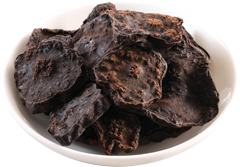 Introduction:
Introduction:
He Shou Wu is the root of Polygonum multiflorum var. hypoleucum, after steam, called as Zhi Shou Wu. The plant was originally found in GuangXi China.
Function:
He Shou Wu: Enchancing the liver and kidney, spirit and blood, has also blacking the hairs and beard functions. He Shou Wu also suitable for fainting and tinnitus, early white hairs, uncomfort of knee and back, annoy or insomnia and high cholesterol.
Characteristics:
Slightly bitter in taste, slightly warm in nature.
Processing method:
He Shou Wu washed by water thoroughly then can be served for cooking.
Way of Storage:
Place the He Shou Wu in cool and dry place. If it is to be stored for some time before serving, it should be sealed and place in refrigerator (0-8˚C).
Serving Suggestions:
He Shou Wu (25g), Wen dang (Codonopsis pilosula) (30g), Bei Qi (Radix astragali) (15g), Shu Di Huang (Processed Rehmannia glutinosa) (25g), Huang Jing (Rhizoma Polygonati) (25g), Silkie Chicken 1, Adequate Sweet Jujube Boil the above Ingredients with adequate water, then you can enjoy a delicious soup. Enhancing kidney, liver, Yi and Qi.
Ba Ji
Introduction:
Ba Ji is the root of morinda, after steam, called as Zhi Shou Wu. The plant was originally found in GaoYao, GaungDong, China. Salt Ba Ji is more helpful for kidney functions.
Function:
Ba Ji: is very good for ridding of damp cold. Strengthen tendons and bones, enhancing kidney and loin, suitable for damp cold and painful lower abdomen → weak and achy loin and knees, weakness of limbs.
Characteristics:
Slightly sweet and hot in taste, warm in nature.
Processing method:
Chop Ba Ji into small sections, take away the codes of the middle part, washed by water thoroughly then can be served for cooking.
Way of Storage:
Place the Ba Ji in cool and dry place. If it is to be stored for some time before serving, it should be sealed and place in refrigerator (0-8˚C).
Serving Suggestions:Ba Ji (25g), Heart shaped Jujube (5), Chestnut (400g), Ginger (2 slices), Pig tail (1) Boil the above Ingredients with adequate water, and you can enjoy a delicious soup. Enhancing the loin and kidney, liver, strengthen the tendons and bones.
Du Zhong
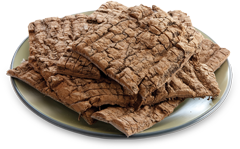 Introduction:
Introduction:
Du Zhong is the cortex of the plant Eucommia ulmoides Oliv, The plant was originally found in Szechwan, China. The functions of the salty Du Zhong are much better.
Function:
Du Zhong:Enhancing liver and kidney, strengthen the tendons and bone, improving the blood pressure. Suitable for painful back and knees or too frequent urination.
Characteristics:
Slightly sweet and hot in taste, warm in nature.
Processing method:
Cut Du Zhong into small pieces, washed by water thoroughly then can be served for cooking.
Way of Storage:
Place the Du Zhong in cool and dry place. If it is to be stored for some time before serving, it should be sealed and place in refrigerator (0-8˚C).
Serving Suggestions:
Du Zhong (25g), Deer Tail (20g), Heart shaped Jujube (5), Huai Niu Xi (25g), Sang Ji Sheng (50g), Tender Ribs (800g) Boil the above Ingredients with adequate water, and you can enjoy a delicious soup. Enhancing the liver and kidney, strengthen the tendons and bones.
Lu Jin
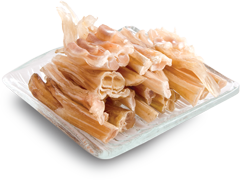 Introduction:
Introduction:
Lu Jin is simply the dried limb tendon of Sika deer or red deer , it is mainly produced in New Zealand and Europe.
Function:
Dried deer tendon could assist to improve joint mobility, bone strength and provide relief from arthritis and joint pain. It is suitable for people who concern about joint, sinew and bones health.
Characteristics:
Slightly sweet and hot in taste, warm in nature.
Processing method:
Lu Jin into small pieces washed by water thoroughly can then be served for cooking.
Way of Storage:
Place the Lu Jin in cool and dry place. If it is to be stored for some time before serving, it should be sealed and place in refrigerator (0-8˚C).
Serving Suggestions:
Lu Jin (25g), White Lotus Seed (50g), Peanut (100g), Ginger 2 slices, Chicken legs (8), Tender Ribs (800g) Boil the above Ingredients with adequate water and you can enjoy a delicious soup. Strengthen the back, knees and legs.
